The market for Paper Vacuum Bags is poised for significant transformation by 2025, driven by rapid innovations and evolving consumer preferences. According to a report by Smithers Pira, the global paper packaging market is projected to grow at a CAGR of 3.4%, reaching a value of $500 billion by the end of the decade. This growth is mirrored in the vacuum bag segment, where Paper Vacuum Bags are gaining traction due to their eco-friendly attributes and superior performance in food preservation and storage. As sustainability becomes a priority for both consumers and manufacturers, the demand for biodegradable and recyclable packaging solutions like Paper Vacuum Bags is expected to rise sharply. Furthermore, advancements in material technology and barrier properties are set to enhance the functionality of these products, ensuring they meet the rigorous demands of modern-day applications. As we delve into the innovations driving this sector, it becomes clear that Paper Vacuum Bags will play a pivotal role in shaping consumer choices and market trends in the coming years.

Advancements in vacuum bag technology are significantly influencing sustainability efforts across various sectors. As the global market increasingly embraces eco-friendly practices, innovations in vacuum packaging are rising to meet these needs. The growing awareness about environmental sustainability has led manufacturers to develop vacuum bags that are not only efficient in preserving food and products but also minimize plastic waste. For example, the integration of biodegradable materials and compostable options into vacuum bag production is a promising step towards reducing the environmental footprint.
Moreover, the shift towards lightweight composite structures enhances both product efficiency and sustainability. By utilizing advanced materials in vacuum bags, manufacturers can reduce the amount of plastic required while maintaining durability and performance. This trend aligns with growing consumer demand for sustainable packaging solutions and complements ongoing efforts to combat plastic pollution. As the vacuum packaging market is forecasted to grow significantly by 2028, these innovations play a crucial role in shaping a more sustainable future for packaging industries.
As the demand for best paper vacuum bags continues to rise, understanding the key regulations and certifications for importing and exporting these products is paramount for businesses in the industry. Compliance with various international standards ensures that vacuum bags not only meet quality requirements but also adhere to safety and environmental norms. Organizations such as ISO (International Organization for Standardization) and ASTM (American Society for Testing and Materials) have developed guidelines that manufacturers must follow, promoting consistency and reliability in vacuum bag production.
Additionally, navigating through import and export regulations can be intricate, as different countries have specific requirements. For instance, the European Union has stringent regulations regarding packaging materials to ensure they are safe for public health and the environment. Companies looking to enter new markets must stay updated on these regulations and acquire necessary certifications, which can vary depending on the target country. Achieving the required certifications not only opens doors to new markets but also enhances customer trust and enhances brand reputation in an increasingly competitive landscape.

As we advance toward 2025, the vacuum bag market is increasingly influenced by shifting consumer preferences, driving innovations in design and functionality. According to a recent industry report by Grand View Research, the global vacuum cleaner bags market is projected to reach $3.4 billion by 2025, indicating a growing demand for more efficient and eco-friendly solutions. Consumers are now prioritizing sustainability alongside performance, prompting manufacturers to explore biodegradable materials and recyclable options in their vacuum bag designs. This alignment with environmental consciousness reflects a broader trend in consumer behavior that values both convenience and ecological responsibility.
In addition to sustainability, the demand for enhanced usability features is reshaping the vacuum bag landscape. Research indicates that 75% of consumers prefer bags that include indicators for fill levels and ease of disposal. This trend underscores the importance of user-friendly designs that cater to consumer convenience, allowing for timely changes and reducing the hassle often associated with vacuum maintenance.
**Tips:**
Consider opting for vacuum bags that feature compatibility with a variety of vacuum models, as this flexibility is becoming a standard preference among users. Additionally, look for products with clear fill indicators to maximize efficiency and avoid unexpected bag changes during cleaning sessions. Consumers should also seek out options that emphasize durability while ensuring easy disposal methods to contribute positively to the environment.
This chart illustrates the consumer preferences influencing the innovations in vacuum bag design for the year 2025. It highlights key features that consumers prioritize and the percentage of importance they assign to each feature.
The market for vacuum bags is poised for significant transformation as automation and smart features become integral to production processes. Companies in the vacuum bag manufacturing sector are increasingly adopting automation technology to enhance efficiency, reduce labor costs, and improve product quality. This transition mirrors broader trends across various industries, where automation is driving substantial improvements in operational workflows and product innovations.
Moreover, the incorporation of smart features into vacuum bags, such as sensors that can detect when a bag is full or needs to be replaced, is becoming an attractive selling point for environmentally conscious consumers and businesses alike. This aligns with the ongoing global push towards sustainability and energy efficiency. As more manufacturers turn towards these innovative technologies, we can expect a future market landscape that not only prioritizes advanced production techniques but also echoes the evolving demands of consumers who are looking for smarter and more efficient cleaning solutions. With automation leading the charge, the vacuum bag industry is set to redefine traditional practices, paving the way for a more dynamic and responsive marketplace by 2025.
| Feature | Description | Impact on Market | Expected Adoption Rate (% by 2025) |
|---|---|---|---|
| Automation | Integration of automated production processes for efficiency | Increased production speed and reduced labor costs | 70% |
| Smart Features | Smart sensors for optimal filling and sealing | Enhanced user experience and reduced wastage | 60% |
| Eco-Friendly Materials | Use of biodegradable and recyclable materials | Appeals to environmentally conscious consumers | 65% |
| Customization | Personalized designs and sizes for customer needs | Increased customer satisfaction and loyalty | 55% |
As the vacuum bag industry evolves, new players must navigate the competitive landscape with innovative market entry strategies. Understanding consumer needs and incorporating advanced technologies into vacuum bag designs can provide a significant edge. This is particularly vital in a landscape where traditional products are being challenged by advancements in materials and design efficiency. By leveraging eco-friendly materials and enhancing functionality, companies can attract environmentally conscious consumers and those seeking superior performance.
Moreover, effective marketing tactics tailored to specific demographics will be essential for newcomers. Building brand awareness through targeted digital campaigns and partnerships with influencers can create a buzz around new products. Engaging potential customers through social media and educational content about the benefits of high-quality vacuum bags can also enhance customer loyalty and drive sales. Focusing on differentiating offerings and creating strong brand narratives will be key aspects of successful market entry, ensuring that new entrants not only survive but thrive in the increasingly competitive vacuum bag industry by 2025.

